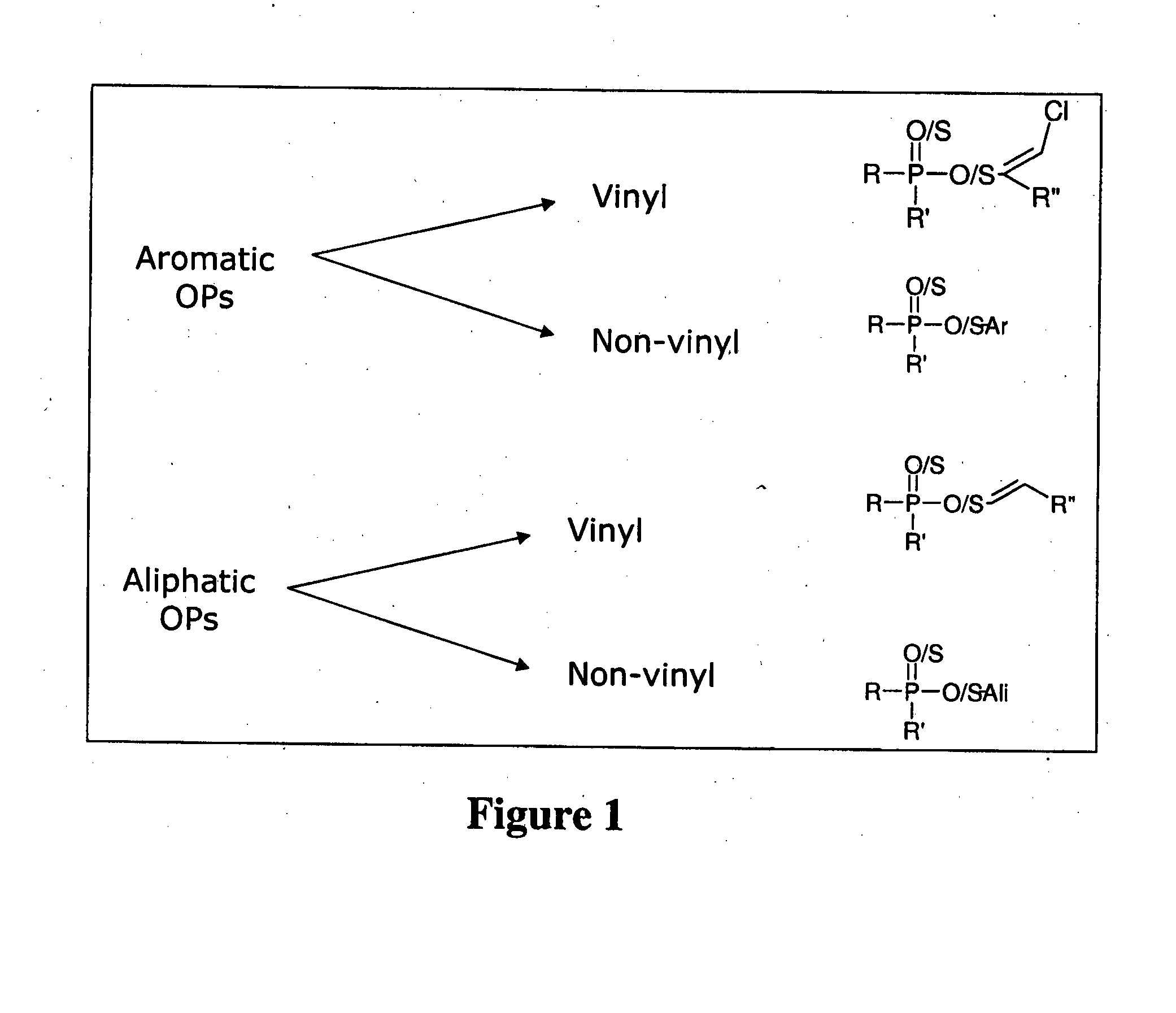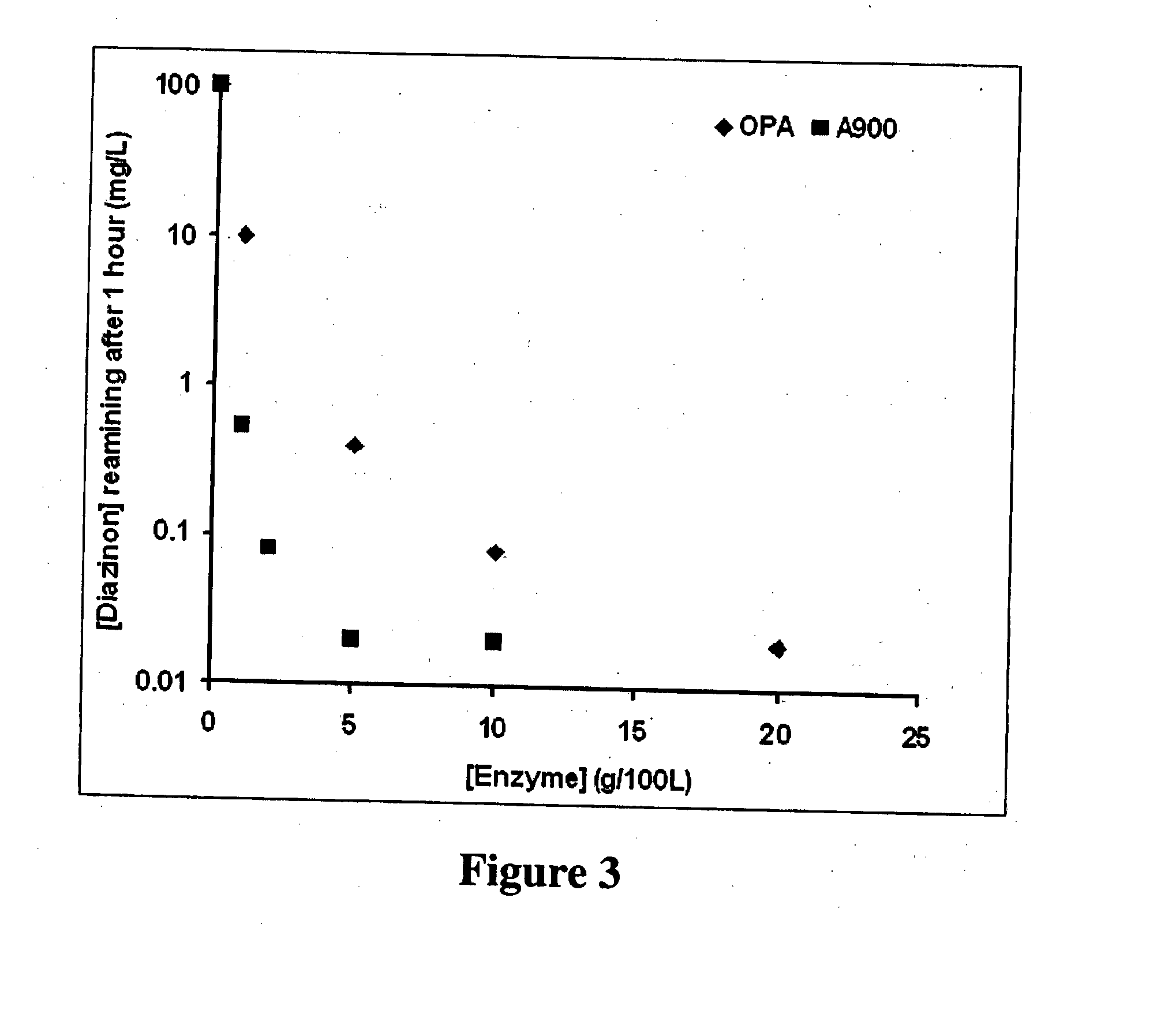Enzymes for degrading organophosphates
a technology of organophosphate and enzymes, which is applied in the field of enzymes capable of hydrolyzing organophosphate (op) molecules, can solve the problems of unsatisfactory organophosphate (op) insecticide residues, needing to detoxify these stocks, and presenting a problem for agricultural workers
- Summary
- Abstract
- Description
- Claims
- Application Information
AI Technical Summary
Benefits of technology
Problems solved by technology
Method used
Image
Examples
example 1
OpdA Variant A900 has Enhanced Activity when Compared to OpdA
Enzyme Production
[0178]A plasmid was constructed including a coding region having the nucleotide sequence of SEQ ID NO: 6 that encoded the amino acid sequence of SEQ ID NO: 1. A stock E. coli BL21 (DE3) culture in glycerol was removed and transformed with plasmid DNA encoding the enzyme. A few colonies of E. coli were scraped from the transfer plate and dipped into nutrient media and incubated at 37° C. (Primary seed). At a certain cell concentration a small amount was added to flasks containing 500 mL of media. The secondary seeds were similarly incubated and at a certain cell concentration were pooled and used as inoculum for the fermenter (1,000 L).
[0179]A 1,000 L fermenter was charged with nutrient medium (600 L) of defined composition followed by sterilisation at 121° C. for 1 hour. Following sterilisation the medium was adjusted to pH 7 and inoculum added so as to initiate fermentation. The conditions of temperature,...
example 2
Improved Steady State Kinetics of A900 Compared with OpdA, OPH and the Best Methyl Paraoxon Degrading OpdA Variant in the Literature (M4)
[0196]kcat / KM values were obtained for enzymes (OPH, OpdA, OpdA900 (SEQ ID NO:1 further comprising an N-terminal Met) and OpdA M4) purified by the methods described in Jackson et al. (2006). OPH is an alternative organophosphate hydrolase from Pseudomomas dimuta (Dumas et al., 1989b), OpdA900 and OpdA M4 are variants of OpdA. M4 was the variant of OpdA that had the greatest reported activity as tested against the OP insecticide methyl paraoxon (Jackson et al., 2009). M4 was 98.8% identical to the wild-type OpdA, A900 was 98.5% identical to wild-type OpdA, and M4 was 98.8% identical to A900 (Table 2).
TABLE 2Percent identity of the OpdA variants investigated in this study.SequenceOpdAM4A900OpdA100.098.898.5M498.8100.098.5A90098.598.5100.0
[0197]Protein concentrations were measured by UV absorption at 280 nm using a Nanodrop ND 1000 spectrophotometer (...
example 3
Toxicity of OpdA and the OP Metabolites
Toxicity of OpdA
[0200]The toxicity of OpdA to mammals was established in formal toxicity studies with Wistar rats (Table 4). OpdA was either fed or applied dermally to the animals (Table 4) at dose rates of 50, 200 and 1000 mg / kg per day for 28 days (oral) or at 4 mL / kg of a 500 mg / mL solution per day for 15 days (dermal). Biopsies revealed no noticeable detrimental effects of oral OpdA application in the rats, whilst the dermal application produced a mild skin irritation with no clinical effects.
[0201]The environmental toxicity of OpdA was tested by applying it at 1 g / L to activated sludge, and at 100 mg / L to cultures of the alga Scenedesmus subspicatus, the arthropod Daphnia magna, and the fish species Brachydanio rerio, with no adverse affects found in any of these indicator species (Table 4). The dose rates used in these toxicity and ecotoxicity studies were higher than in many of the successful field trials of the enzyme's efficacy as a bi...
PUM
| Property | Measurement | Unit |
|---|---|---|
| pKa | aaaaa | aaaaa |
| time | aaaaa | aaaaa |
| pH | aaaaa | aaaaa |
Abstract
Description
Claims
Application Information
 Login to View More
Login to View More - R&D
- Intellectual Property
- Life Sciences
- Materials
- Tech Scout
- Unparalleled Data Quality
- Higher Quality Content
- 60% Fewer Hallucinations
Browse by: Latest US Patents, China's latest patents, Technical Efficacy Thesaurus, Application Domain, Technology Topic, Popular Technical Reports.
© 2025 PatSnap. All rights reserved.Legal|Privacy policy|Modern Slavery Act Transparency Statement|Sitemap|About US| Contact US: help@patsnap.com



